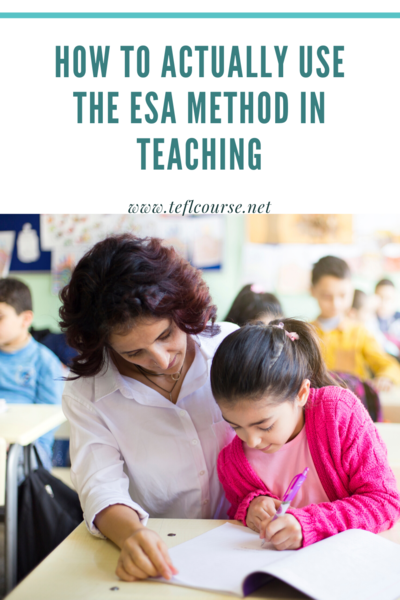How to Actually Use the ESA Method in Teaching

The Engage, Study, Active (ESA) method is a combination of different methods. It was created by Jeremy Harmer when he wrote the book called "How to Teach English" in 1998. In this book, he gives an overview of the different methodologies such as Task-Based Learning, Community Language Learning, and Suggestopedia. He then describes a new methodology: ESA. This method has three main parts that are utilized in different ways to create three distinct ESA lessons discussed below.
Table of Contents
Do you want to teach English abroad? Take a TEFL course!
This post was written by our TEFL certification graduate Kelly H. Please note that this blog post might not necessarily represent the beliefs or opinions of ITTT.
Lesson Stages
The first part is the Engage Phase. This phase is used to warm students up. It is not appropriate to correct students during this phase, because this time should be spent on encouraging the student. If the students make mistakes, this can be recorded and addressed in the study phase. In this phase, the teacher may ask the students questions about what type of food, colors, or clothes they like (assuming they have some background in the area).
The second part is the Study Phase. In this phase, students study new material. The teacher may elicit sentence structures or vocabulary depending on the topic. The teacher will review the material with the students and then the students will practice the material using a worksheet, for example.
In the Activate Phase, the students practice using the material in different situations and often present it to the class. For example, if the class topic was about giving directions at the zoo during the Study Phase, a map would be used as a study material. Then in the Activate Phase, the students would be given a new map and they would practice giving each other directions. Each of these phases is important and help the student gain confidence while effectively practicing and enhancing their fluency or accuracy.

Also Read: What is the best TEFL course to do in Thailand?
Types of Lesson Plans
The ESA Method has three different types of lesson plans. There is the "Straight Arrow" ESA lesson, "Boomerang" ESA lesson, and the "Patchwork" ESA lesson. The "Straight Arrow" ESA starts with the Engage Phase, with the Study Phase in the center, and finally ends with the Activate Phase. This method best suits beginner levels. It allows newer students to gain confidence by reviewing difficult material before using it in the Activate Stage. In the "Boomerang" ESA lesson, the lesson starts with the Engage Phase, then Activate Phase 1, followed by a Study Phase, and finally Activate Phase 2. This type of lesson is used for intermediate and sometimes advanced students. However, the "Patchwork" ESA lesson is a great format for advanced level students. In this lesson format, it starts with the Engage Phase and ends in an Activate Phase, but in between the first and last phase, it can be a combination of the Engage, Study, and the Activate Stage. Both the "Patchwork" and "Boomerang" ESA lessons provide a more challenging lesson format.
Do you want to teach English abroad? Take a TEFL course!
To summarize, the ESA method utilizes effective techniques from other methodologies. It provides different lesson types, while maintaining an effective structure, meaning that in each lesson, no matter the level, the students will always go through an Engage Phase, a Study Phase, and an Activate Phase at least once.
Apply now & get certified to teach english abroad!
Speak with an ITTT advisor today to put together your personal plan for teaching English abroad.
Send us an email or call us toll-free at 1-800-490-0531 to speak with an ITTT advisor today.
Related Articles:
- 3 Awesome Reasons to Become an EFL Teacher Abroad
- Top 10 Things To Know When Moving Abroad To Teach English
- How To Write The Perfect ESL Lesson Plan
- Online or In-Class - Which TEFL Course Should You Take?
- How To Write The Perfect ESL Lesson Plan
- Getting Student Placement Right - The Best Desk Arrangements for EFL Students




